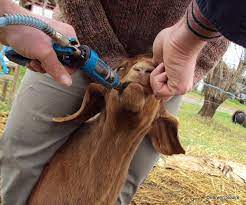Deworming sometimes known as worming or drenching is the giving of an anthelmintic drug often referred to as a wormer, dewormer, or drench to a human or animal to rid them of helminth parasites, such as roundworm, flukes and tapeworm.
Deworming or drenching is a fundamental practice in livestock management that helps control internal parasites, improving the health, productivity, and overall well-being of animals. Regular and strategic deworming, combined with good pasture and herd management practices, ensures that livestock remain healthy and productive.
Deworming (drenching) refers to the process of administering medication to livestock to eliminate internal parasites, primarily gastrointestinal worms. These parasites can include roundworms, tapeworms, flukes, and other harmful worms that reside in the digestive tract and other internal organs of animals.
Importance of Deworming (Drenching) Animals
1. Health Improvement Benefits
a. Nutrient Absorption: Worm infestations can lead to poor nutrient absorption, as parasites compete with the host for nutrients. Deworming helps restore proper nutrient uptake, improving overall health.
b. Growth and Weight Gain: By removing parasites, animals can better utilize their feed, leading to improved growth rates and weight gain.
2. Disease Prevention Benefits
a. Reduce Disease Transmission: Deworming reduces the load of internal parasites, decreasing the risk of diseases associated with heavy infestations, such as anemia, diarrhea, and tissue damage.
b. Enhance Immune Function: Healthier animals with fewer parasites have stronger immune systems, making them less susceptible to other diseases.
3. Productivity and Performance Benefits
a. Increased Production: Healthy animals are more productive. Deworming can lead to increased milk yield in dairy animals, better wool quality in sheep, and higher meat production in all livestock.
b. Reproductive Efficiency: Dewormed animals tend to have better reproductive performance, including higher conception rates and healthier offspring.
Methods of Deworming or Drenching Animals

Deworming, also known as drenching, is a critical practice in animal husbandry that involves the administration of anthelmintic drugs to livestock to control internal parasites. These parasites, such as worms, can significantly impact the health, productivity, and overall well-being of animals. Here is a detailed procedure of deworming:
Procedure
• Put the liquid into a bottle with a long neck, or put a short piece of plastic or rubber tubing over the neck of a bottle. The best type of bottle for drenching is a long-necked wine bottle. A Coca-Cola bottle is a good alternative.
• Hold the sheep in a standing position with its head slightly up.
Put the end of the bottle or tube into the back of the mouth above the tongue
• Tip the bottle so that the liquid run slowly out into the mouth and is swallowed.
• A pill or bolus can sometimes be given by placing it, with the fingers, at the back of the sheep’s mouth and pushing it down the esophagus. An easier method, if treating many sheep, is to use a commercial balling gun.
Read Also: Mulching: Meaning and Benefits of Mulching
Deworming Process: How to Properly Deworm Your Animals
1. Assessment Stage
a. Fecal Egg Count (FEC): Before deworming, a fecal egg count can be performed to determine the type and burden of parasites, guiding the choice of anthelmintic.
b. Physical Examination: Regular physical checks for signs of worm infestation, such as weight loss, rough coat, diarrhea, and lethargy.
2. Choosing the Right Anthelmintic
a. Broad-spectrum vs. Specific: Broad-spectrum anthelmintics target a wide range of parasites, while specific anthelmintics are used for particular types of worms.
b. Drug Rotation: To prevent resistance, it’s advisable to rotate anthelmintics periodically, using different classes of drugs.
3. Administration Methods
a. Oral Drenching: The most common method, involving a liquid formulation administered orally using a drenching gun or syringe.
b. Injectable Dewormers: Used for certain types of worms and in cases where oral administration is impractical.
c. Topical Applications: Pour-on or spot-on formulations applied to the skin, which are absorbed into the bloodstream.
Read Also: Rabbit Housing Requirements
Best Practices for Deworming Your Animals
1. Regular Schedule: Deworm animals on a regular schedule based on the specific needs of the herd or flock, typically every 3-6 months.
2. Pasture Management: Implement rotational grazing and avoid overgrazing to reduce parasite loads in pastures.
3. Hygiene and Sanitation: Maintain clean living conditions to minimize exposure to parasite eggs and larvae.
4. Monitoring and Record Keeping: Keep detailed records of deworming dates, drugs used, and dosages to track effectiveness and avoid resistance.
Read Also: Sustainable Development: Building a Better Future for All

